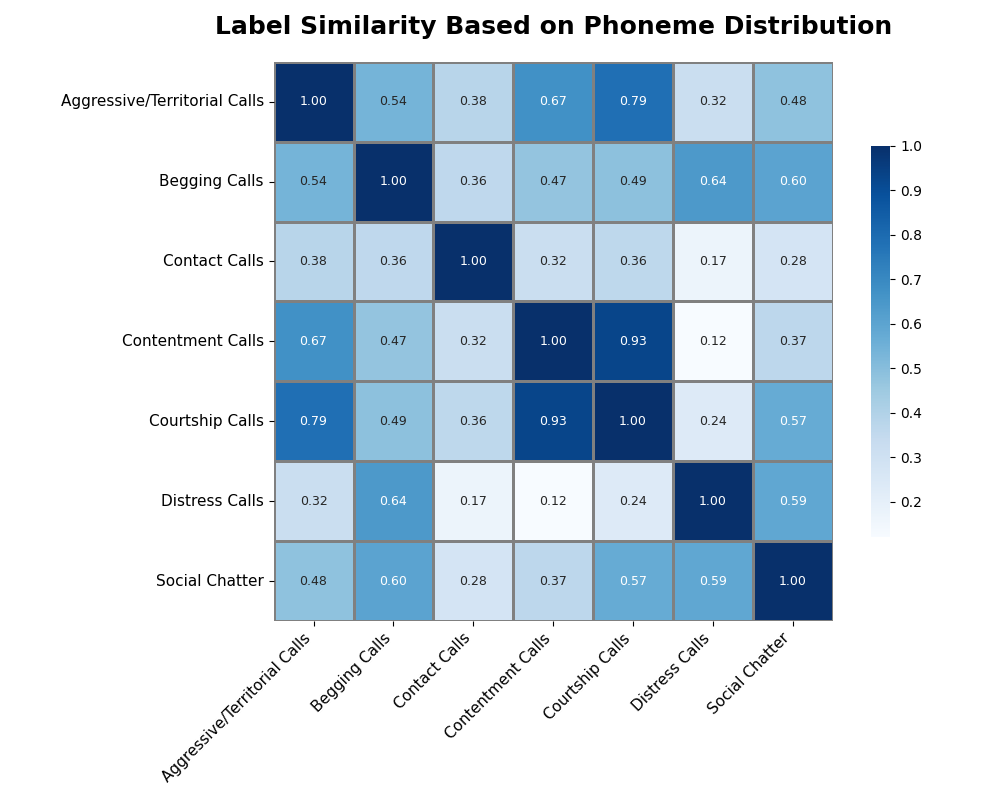Budgie Sounds and Meanings: Analyzing Call Type Similarities Through Phoneme Patterns

Budgies are some of the most vocal and socially complex birds. Through various sounds and calls, they express emotions ranging from excitement and affection to stress and urgency. In this analysis, I explore the idea that not only are these calls behaviorally distinct, but their underlying phoneme structures—the basic building blocks of their sounds—carry deep similarities and differences depending on the context.
Building on earlier work where I clustered budgie phonemes using machine learning techniques, this new phase of analysis expands the labeled dataset to over 54 samples. These samples include videos of my own budgies, Baden-Baden and Jojo, as well as carefully selected TikTok videos featuring clear, background-noise-free bird vocalizations.
Observations from the Phoneme Similarity Analysis

The heat map above illustrates the similarity between different labels based on their phoneme distributions. In this visualization, a similarity score of 1 indicates that two labels are highly related in terms of phonetic structure, while a score of 0 means there is no phonetic relationship between them.
The color intensity represents the degree of similarity:
- Deeper blue shades indicate higher similarity.
- Lighter shades represent lower similarity.
This analysis provides an intuitive way to explore patterns in how labels sound, uncovering hidden relationships that may not be immediately obvious from the text alone.
Courtship Calls and Contentment Calls Are Highly Similar
Courtship and contentment calls showed a very high similarity score of 0.93. This suggests that the phoneme patterns used during positive, bonding behaviors are extremely close. In social species like budgies, the overlap between affection-driven communication and relaxed social interaction makes intuitive sense.
Aggressive Calls Share Some Structure with Courtship and Contentment
Aggressive or territorial calls were moderately similar to both courtship (0.79) and contentment calls (0.67). This may seem surprising at first, but it suggests that aggression in budgies may not always be sharply distinct—it could share some “base language” elements with social interaction, perhaps intensified or delivered differently.
Contact Calls Are Distinct
Contact calls showed relatively low similarity with all other behaviors. Their primary function—keeping in touch with other flock members—likely drives a need for a distinct, easily recognizable sound, different from emotionally charged calls.
Distress Calls Are Related to Social Chatter and Begging Sounds
Distress calls show a relatively strong relationship with both begging sounds and social chatter. Begging calls are typically made when an individual needs something, while social chatter is linked to maintaining social bonds. The strong connection between these two types of calls might suggest that distress calls are, in part, a way of calling out to the group for support — which makes intuitive sense.
Hypotheses Based on These Patterns
The observations suggest a few working hypotheses:
- Emotional Similarity Mirrors Phoneme Similarity: Positive social behaviors like courtship and contentment reuse similar phonemes, reflecting an emotional continuum.
- Behavioral Overlap Drives Blending: Begging calls blend phonemic elements from both distress and social chatter, matching their dual emotional role.
- Functionality Demands Distinction: Contact calls are structurally distinct because clarity and urgency are critical for survival of budgies in the wild
- Base Phonemes Are Modulated by Context: Rather than inventing entirely different sounds, budgies may adjust familiar phonemes depending on urgency, emotional intensity, or social needs.
Context
The goal is simple: to begin deciphering what different phoneme clusters might mean, much like how linguists study ancient, undeciphered languages. By comparing how often certain phonemes occur and the behaviors they accompany, we can start building the foundations for a better understanding of budgie communication.
Eight core phonemic patterns were identified. Earlier analysis using the Elbow Method showed a clear inflection point in the inertia curve at eight clusters, indicating a well-defined struct
How Similarity Was Measured: A Simple Explanation
To measure how similar different call types are, I used something called cosine similarity.
Imagine each budgie call type as a point in space, defined by how much it uses each phoneme. Cosine similarity is a way of calculating how close two points are based not on distance, but on direction.
If two call types use phonemes in very similar proportions, their “directions” are close, and cosine similarity will be near 1. If they use very different phonemes, the similarity will be closer to 0. In short, cosine similarity helps tell us whether two behaviors “sound similar” based on their phoneme patterns, even if the overall number of sounds is different.
Final Thoughts
This early exploration into budgie phoneme patterns hints at the incredible complexity of their vocal communication. Much like how human language evolved from a small set of sounds into complex expressions, budgies may rely on a flexible, modular system of phonemes adapted to different behavioral contexts.
While this work is only the beginning, it lays important groundwork. By continuing to map phoneme patterns to observed behaviors, we move closer to the dream of understanding not just what budgies say—but what they mean.
